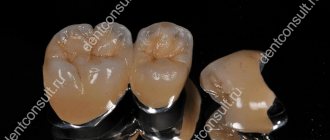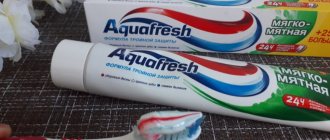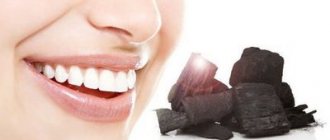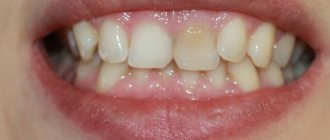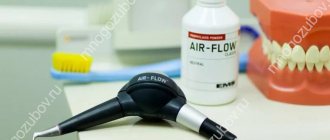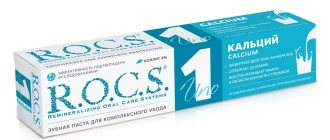How does toothpaste whiten?
Today, aesthetic dentistry divides whitening pastes into three types, which differ in the principle of their effect on the tooth surface:
Mechanical impact
All toothpastes contain various abrasives, but whitening toothpastes contain larger abrasive particles. They act on the enamel like a scrub, mechanically removing yellow surface plaque, and also intensively polish the teeth. But an increase in abrasiveness also means that there is a high probability of injury to the enamel along with the gums. Therefore, regular use of such pastes can lead to hyperesthesia - increased tooth sensitivity.
Chemical exposure
In order to achieve a whitening effect, low-percentage solutions of hydrogen peroxide or urea are added to the paste. Active enzymes of the substance interact with yellow plaque, oxidizing pigments and thereby making teeth a little lighter. In addition to peroxide, whitening toothpastes may contain chemical ingredients that lighten teeth by removing stained pellicle (a thin organic film covering tooth enamel).
Preventive effects
Often, the category of whitening pastes includes products aimed at preventing the formation of dental plaque. Various crystallization inhibitors prevent the mineralization of soft yellow plaque and tartar. Such pastes are especially relevant for smokers and coffee lovers. But it should be remembered that their use makes sense only after professional hygienic teeth cleaning in the clinic.
What to choose: whitening or cleansing
In dental practice, there are several procedures that can achieve white enamel. This includes cleaning the crown surfaces and whitening. As a result, after these procedures, the color of the tooth enamel will change, stains and yellowness will disappear .
Read also: Is it possible to treat teeth with braces?
But, despite the same result, the implementation of these procedures differs significantly . By cleansing we mean removing yellow plaque by absolutely any available method (mechanical cleaning, laser, ultrasound, photopaste or paste with abrasive particles).
At the same time, the enamel becomes lighter due to the removal of deposits and stones. The enamel layer remains the same. If this procedure is carried out correctly, this method has practically no contraindications for use.
Exceptions are those circumstances when the enamel is very thin and there is a high risk of damaging it during cleaning. The thickness of the enamel layer is determined visually by its level of transparency. If the enamel is thin, then the dentin will show through from underneath it. It is not recommended to clean it.
After cleansing, the yellowed enamel becomes lighter, but far from snow-white. Natural enamel will take on a barely visible beige tint.
The complexity of this effect lies in the fact that it can be difficult to determine when the plaque ends and the enamel begins. That is why it is advisable to carry out gentle cleaning extremely carefully and no more than once every 2-3 weeks .
The whitening process involves affecting the pigmentation of tooth enamel. In most cases, atomic oxygen is used for this, which is able to penetrate the surface of the tissue (enamel and dentin located underneath) and then destroys it.
Having decided to carry out this procedure at home, you must choose the most preferable method for yourself, which will not only remove plaque well, but also will not injure the enamel.
How to properly carry out this procedure at home
For home whitening, methods based on the two above processes are used:
- cleaning of crowns;
- impact on enamel color.
Now we will look at the most effective and less dangerous methods that are available at home.
Do whitening toothpastes whiten?
There is a clear answer to this question - no, if by teeth whitening we mean a change in their color. You should not believe numerous commercials in which manufacturers promise instant results after using whitening pastes. The most they can do is return the teeth to their natural shade by removing or lightening the yellow plaque that has accumulated on their surface. Thus, there is a slight change in color, but not as a result of bleaching, but rather of cleansing. But you can really whiten your teeth only with the help of professional photo whitening, laser whitening or home whitening with a tray. After this, it makes sense to use whitening toothpaste to maintain the results.
Peroxide
Remember that peroxide whitening pastes will only be effective if you do not have tartar deposits. Therefore, before using them, go to the dentist for cleaning. It will help you tidy up your mouth and whiten your teeth properly. By the way, if you have crowns, they cannot be bleached this way.
| Name | Peculiarities | Price |
| ROCS Pro Oxygen bleaching | Calcium glycerophosphate provides remineralization of tooth enamel, and active oxygen provides deep cleansing, giving a difference of 2-3 tones. | 350 |
| SPLAT Special Extreme White | This paste combines the effect of abrasive and peroxide techniques: it effectively fights plaque using hydrated silicon dioxide. Fluoride at the same time strengthens the enamel. | 200 |
| SwissDent Gentle | The formula with calcium peroxide and fruit enzymes allows you to quickly and effectively whiten your teeth at home. Fluoride in the composition helps the enamel to withstand and strengthen its position. | 1000 |
Who needs whitening toothpaste?
Who is recommended to whiten teeth using special toothpastes? First of all, coffee lovers and smokers, since nicotine and caffeine stain teeth an unpleasant yellow color. Whitening pastes are also suitable for those who have undergone professional teeth whitening and want to maintain the effect for a long time. If you do not belong to any of the listed categories and still want to experience the effects of a toothpaste labeled white, think carefully. For example, such pastes cannot be used for hypersensitive teeth, wedge-shaped defects, gum and periodontal diseases, as well as for children under 12 years of age and pregnant women.
Pastes for lightening tooth enamel: TOP-20 best rating
On the modern market, toothpastes for teeth whitening are presented in a wide range. These products are produced by various manufacturers, each of which offers different types of such hygiene products.
Rating of super tooth whitening pastes that are most popular in Russia:
- LACALUT White. Contains spherical cut abrasives, pyrophosphates and fluorides. They ensure the dissolution of mineralized deposits and the removal of pigmented plaque. The RDA is 120, which allows you to use the paste every two days. The price of Lakalyut for a tube of 50 ml is 220 rubles.
- LACALUT white and repair. In addition to whitening, it has an antiseptic, anti-inflammatory and anti-caries effect. Includes sodium and calcium fluoride; reactions with saliva help restore enamel and create anti-caries protection for it. The cost of a 75 ml tube is 250 rubles.
- PRESIDENT White Plus. Uniqueness is determined by the presence of silicate-based abrasive and calcium abrasive. They stimulate tissue regeneration and have a bactericidal effect. Due to the high abrasiveness coefficient of 200, it quickly eliminates plaque, mineralized deposits and age spots. President's price for 30 ml is 161 rubles.
- PRESIDENT White. Abrasive and polishing components are presented in the form of silicon and calcium, the effect of which is enhanced by fluoride ions and plant extracts. This has additional anti-inflammatory, bactericidal and analgesic effects. You can buy it for 290 rubles.
- Rembrandt anti-tobacco and coffee. The active ingredients are aluminum and silicon oxides. In addition to the abrasive effect, they eliminate plaque and age spots. Due to the presence of papain, mineralizing stones are easily removed, and the high concentration of fluoride prevents their re-formation and remineralizes the enamel. An ideal product for smokers and lovers of strong tea, it can be purchased for 720 rubles for a volume of 50 ml.
- Rembrandt plus. Characterized by rapid whitening under the influence of urea peroxide. The fluoride contained in the composition strengthens the top layer of enamel. Price for a 50 ml tube is 540 rubles.
- Splat whitening plus. Titanium and silicon dioxide, papain and polydone can effectively remove plaque and pigmentation. Fluoride and potassium fights hypersensitivity. On average, Splat costs 85 rubles.
- Splat extreme white. A non-abrasive paste that contains complexing agents that provide complete gentle whitening. It is an effective tool for the prevention of caries. Allowed for everyday use. Price for a 75 ml tube is 192 rubles.
- Silca arctic white. A high concentration of fluoride helps restore the structure of tooth enamel and prevents the appearance of hypersensitivity. Removes plaque of any density. 100 ml of paste can be bought for 128 rubles.
- Rocs sensational whitening. Does not contain fluoride. The bromelain included in the composition helps to break down pigmentation, and calcium glycerophosphate replenishes the deficiency of minerals in the enamel. Price for 60 ml 217 rubles.
- Rocs pro delicate whitening. Contains one type of abrasive. This provides the most gentle effect on the enamel. To enhance the effect, it is advisable to use the pro oxygen whitening gel in parallel. Cost 284 rubles per 60 ml tube.
- Rocs gel pro oxygen whitening. Does not contain fluorine, parabens and sodium lauryl sulfate, low abrasive. Due to the effect of active oxygen, it brightens the enamel from the inside by 2-3 tones in one course. 60 ml costs 375 rubles.
- Crest 3D White Luxe Glamorous White. Due to the combination of sodium fluoride and sodium pyrophosphate, it has a complex effect. The paste whitens and removes plaque and mineralized deposits. The effectiveness is noticeable after the first use. A 100 gram tube costs 532 rubles.
- Blendamed 3d white. It is one of the most common and affordable toothpastes in this category. The product consists of a single abrasive and numerous pyrophosphates. After use, hypersensitivity of tooth enamel may develop. The price of Blendamed for a 75 ml tube is 226 rubles.
- Perfect White Black. It is made on the basis of activated carbon. It has low abrasiveness, which allows you to use this product daily. The presence of fluorides and calcium ensures the strengthening of the enamel. The price of such a product with a volume of 100 ml is 497 rubles.
- Colgate comprehensive whitening. Contains active polishing microcrystals that effectively restore the natural whiteness of enamel. Fluoride-containing paste, which is suitable exclusively for cleansing soft plaque. Prevents re-formation of plaque and caries. Price for a 100 ml tube is 172 rubles.
- Colgate Optic White. In addition to whitening, it has a cleansing and refreshing effect. The main effect is due to the presence of optical whitening granules, which are activated during cleaning. Cost 214 rubles for 75 ml.
- New pearl whitening. Refers to available pastes. It contains a high concentration of pyrophosphates. It has a gentle effect, which allows it to be used by children over 7 years of age. Price for 100 ml 85 rubles.
- White Glo. The presence of effective and safe whitening formulas in its composition allows you to effectively lighten age spots and remove plaque. The high concentration of vitamins and rosehip oil enhances the protective properties of the oral mucosa. Cost for 100 ml 190 rubles.
- Yotuel Classic. A complex of special low-abrasive silicon dioxide with natural enzymes promotes effective teeth whitening even in the interdental spaces without damaging the enamel. The presence of active potassium fluoride and xylitol helps prevent the development of caries and the formation of mineralized deposits. The cost of a 50 ml tube with the name Yotuel Classic is 647 rubles.
Blendamed 3d white
Colgate comprehensive whitening
Colgate Optical White
Crest 3D White Lux Glamorous White
LACALUT White
LACALUT white and repair
Perfect White Black
PRESIDENT White
PRESIDENT White Plus
Rembrandt anti-tobacco and coffee
Rembrandt plus
Rocs pro delicate whitening
Rocs Sensational whitening
Rocs gel pro Oxygen whitening
Silca arctic white
Splat extreme white
Splat whitening plus
White Glo
Yotuel Classic
New pearl whitening
How to choose the best whitening toothpaste?
When choosing a toothpaste, there are several points to pay attention to. First of all, familiarize yourself with the composition of the toothpaste. It should not contain substances with an abrasiveness greater than 25 RDA, especially titanium dioxide. If the paste contains hydrogen peroxide, make sure it does not exceed the permissible limit of 0.1%. Read the instructions for use carefully. Do not forget that toothpaste with a whitening effect cannot be used constantly. Manufacturers may recommend the use of whitening paste in courses of 30–60 days, either twice a week or in another mode.
Most Russian dentists do not recommend their patients to use whitening pastes, as they believe that they contain substances that can have a negative effect on tooth enamel. Are they right? Yes and no. Using whitening pastes if there are contraindications, as well as their uncontrolled use, will really not bring anything good. But if you use such pastes correctly, according to the recommendations and indications, they will not cause harm and will help make your smile, if not brighter, then more attractive. To remove the effect of tooth sensitivity, also use toothpastes with fluoride.
Frequency of teeth whitening
If you decide to whiten your teeth, you should first consult with your doctor not only about the risks and method of the procedure, but also about the result. Quite often the expected whitening effect diverges from the actual result. Modern technologies allow the patient to see what the teeth will look like at the end of the procedure before the session begins and make a decision. If there is a significant change in the shade of the teeth, several whitening sessions are performed at certain intervals.
How often you can resort to whitening depends on the method of performing the procedure:
- Laser teeth whitening involves exposing the enamel to high temperatures, which “evaporate” the pigment. The effect is achieved after the first session. Due to the active action of the gel and laser, you should not resort to the procedure more than once every 12 months.
- Ultrasonic whitening. The result in the form of snow-white teeth is achieved by analogy with laser whitening, but in this case the active action is performed by ultrasonic waves. The procedure is also not recommended for more than 1 time per year.
- Photobleaching. The most famous method is Zoom. This is a unique technique for lightening tooth enamel up to 10–12 tones. Despite this result, photobleaching is recognized as the most gentle method. Its gentle effect does not lead to thinning of the enamel, so the procedure can be repeated after 6 months.
- Professional home methods pose the least risk. The drugs are not designed to have a strong effect, so they do not have an aggressive effect. You can whiten your teeth at home after 4-6 months.
In each case, the dentist makes a decision individually. The next teeth whitening procedure is carried out only after confirmation of complete restoration of the enamel and the absence of any contraindications.
Making a mouth guard from foil
Now you need to make a dental guard. For this you will need regular table foil. How to do it correctly:
- Cut a rectangular piece of foil measuring 10 by 5 cm.
- Fold the material in half lengthwise to make the mouth guard strong.
- Bend the rectangle lengthwise at an angle.
- Place a teaspoon of whitening solution in the tray.
- Place it on the top row of teeth.
- Press well so that the tray tightly envelops the crowns.
- Do the same with the second row of teeth.
Leave the mouth guard for a while, wait until the reagents dissolve the plaque. The foil should remain on the teeth for at least 20-30 minutes. Then you need to remove the strips from your teeth, brush your teeth, and rinse your mouth thoroughly. To freshen your breath, you can rinse your mouth again with a special dental solution.
There is a small warning for those who are interested in how to whiten teeth with soda solutions, foil and toothpaste. The fact is that the whitening procedure can be quite unpleasant. The entire time the trays are in your mouth, you may experience severe drooling and the taste in your mouth will be disgusting. But the result you will see after the procedure is worth it.
